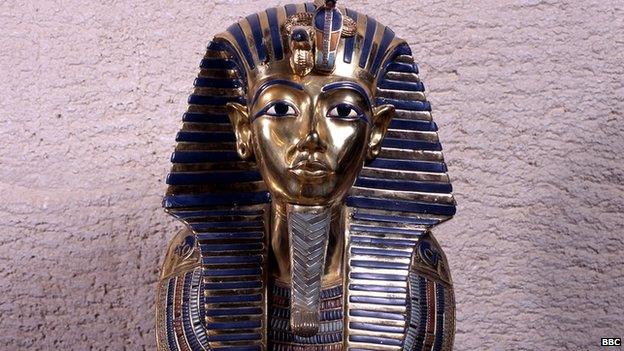Egypt inquiry after Tutankhamun's beard glued back on
- Published

The burial mask of Tutankhamun is among the word's best-known ancient artefacts
The blue and gold braided beard on the burial mask of pharaoh Tutankhamun has been hastily glued back on after it was damaged, museum employees say.
But conservators at the Egyptian Museum in Cairo gave differing accounts of the exact circumstances.
It is not clear whether the mask was damaged during cleaning or if the beard was removed because it was loose.
The 3,000-year-old artefact, with other relics from the boy king's tomb, is among Cairo's biggest attractions.
An inquiry is under way into what happened to one of the country's greatest treasures.
Instead of being taken to a conservation lab, the repair was performed quickly to put the mask back on display, conservators say.
'Quick fix ordered'
The ┤¾¤¾┤½├¢'s Orla Guerin, who has seen the mask, says a glue-like substance is visible along the join between the beard and the rest of the mask. The two pieces were made separately and have always been fixed together.
One of the museum conservators told AP news agency that quick-drying glue was used to re-attach the beard.
A second one who was present at the time of the repair said the glue had dried on the mask and that a colleague used a spatula to remove it, leaving scratches.
A close-up of the mask shows the glue used to reattach the beard
Both conservators spoke on condition of anonymity, but they agreed that orders for a quick fix must have come from above.
The director of the Egyptian Museum, Mahmoud Al Hawagi, confirmed to the ┤¾¤¾┤½├¢ that a translucent adhesive material had appeared on the burial mask.
The ministry of antiquities was now investigating how this happened, he added.
A photograph has been published which allegedly shows a botched repair taking place last August.
The picture, which has not been independently verified, shows two men in T-shirts and surgical gloves working on the artefact. One has his bare forearm inside the mask.
The Egyptian Museum is among Cairo's top tourist sites, but in some areas ancient artefacts lie unprotected from the public.
Egypt's tourist industry, once a key source of revenue, has yet to recover from the years of turmoil that followed the overthrow of former President Hosni Mubarak in 2011.
Tutankhamun's burial mask was discovered in 1922 along with the pharaoh's nearly intact tomb and sparked worldwide interest in archaeology and ancient Egypt.
The Egyptian Museum, restored in 2014, is one of Cairo's main tourist attractions
- Published16 December 2014
- Published7 January 2019